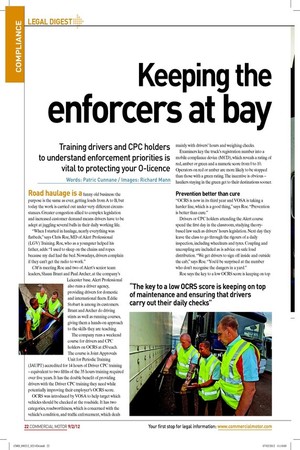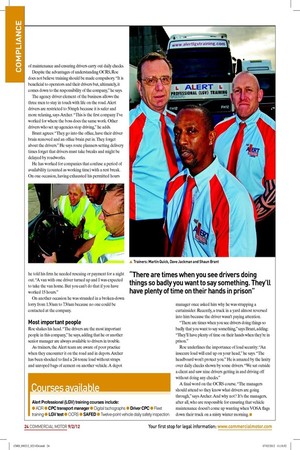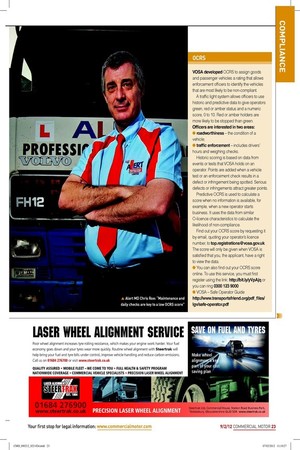Keeping the
Page 16

Page 18

Page 17

If you've noticed an error in this article please click here to report it so we can fix it.
enforcers at bay
Training drivers and CPC holders to understand enforcement priorities is vital to protecting your O-licence
Words: Patric Cunnane / Images: Richard Mann Road haulage is a funny old business: the purpose is the same as ever, getting loads from A to B, but today the work is carried out under very different circumstances. Greater congestion allied to complex legislation and increased customer demand means drivers have to be adept at juggling several balls in their daily working life.
“When I started in haulage, nearly everything was latbeds,” says Chris Roe, MD of Alert Professional (LGV) Training. Roe, who as a youngster helped his father, adds: “I used to sleep on the chains and ropes because my dad had the bed. Nowadays, drivers complain if they can’t get the radio to work.” CM is meeting Roe and two of Alert’s senior team leaders, Shaun Brant and Paul Archer, at the company’s Leicester base. Alert Professional also runs a driver agency, providing drivers for domestic and international leets. Eddie Stobart is among its customers. Brant and Archer do driving stints as well as running courses, giving them a hands-on approach to the skills they are teaching.
The company runs a weekend course for drivers and CPC holders on OCRS at £50 each. The course is Joint Approvals Unit for Periodic Training (JAUPT) accredited for 14 hours of Driver CPC training – equivalent to two ifths of the 35 hours training required over ive years. It has the double beneit of providing drivers with the Driver CPC training they need while potentially improving their employer’s OCRS score.
OCRS was introduced by VOSA to help target which vehicles should be checked at the roadside. It has two categories, roadworthiness, which is concerned with the vehicle’s condition, and trafic enforcement, which deals mainly with drivers’ hours and weighing checks.
Examiners key the truck’s registration number into a mobile compliance device (MCD), which reveals a rating of red, amber or green and a numeric score from 0 to 10. Operators on red or amber are more likely to be stopped than those with a green rating. The incentive is obvious – hauliers staying in the green get to their destinations sooner.
Prevention better than cure
“OCRS is now in its third year and VOSA is taking a harder line, which is a good thing,” says Roe. “Prevention is better than cure.” Drivers or CPC holders attending the Alert course spend the irst day in the classroom, studying theorybased law such as drivers’ hours legislation. Next day they leave the class to go through the rigours of a daily inspection, including wheelnuts and tyres. Coupling and uncoupling are included as is advice on safe load distribution. “We get drivers to sign off inside and outside the cab,” says Roe. “You’d be surprised at the number who don’t recognise the dangers in a yard.” Roe says the key to a low OCRS score is keeping on top of maintenance and ensuring drivers carry out daily checks.
Despite the advantages of understanding OCRS, Roe does not believe training should be made compulsory. “It is beneicial to operators and their drivers but, ultimately, it comes down to the responsibility of the company,” he says.
The agency driver element of the business allows the three men to stay in touch with life on the road. Alert drivers are restricted to 50mph because it is safer and more relaxing, says Archer. “This is the irst company I’ve worked for where the boss does the same work. Other drivers who set up agencies stop driving,” he adds.
Brant agrees: “They go into the ofice, have their driver brain removed and an ofice brain put in. They forget about the drivers.” He says route planners setting delivery times forget that drivers must take breaks and might be delayed by roadworks.
He has worked for companies that confuse a period of availability (counted as working time) with a rest break. On one occasion, having exhausted his permitted hours he told his irm he needed rescuing or payment for a night out. “A van with one driver turned up and I was expected to take the van home. But you can’t do that if you have worked 15 hours.” On another occasion he was stranded in a broken-down lorry from 1.30am to 7.30am because no one could be contacted at the company.
Most important people
Roe shakes his head. “The drivers are the most important people in this company,” he says, adding that he or another senior manager are always available to drivers in trouble.
As trainers, the Alert team are aware of poor practice when they encounter it on the road and in depots. Archer has been shocked to ind a 24-tonne load without straps and unroped bags of cement on another vehicle. A depot manager once asked him why he was strapping a curtainsider. Recently, a truck in a yard almost reversed into him because the driver wasn’t paying attention.
“There are times when you see drivers doing things so badly that you want to say something,” says Brant, adding: “They’ll have plenty of time on their hands when they’re in prison.” Roe underlines the importance of load security: “An insecure load will end up on your head,” he says. “The headboard won’t protect you.” He is amazed by the laxity over daily checks shown by some drivers. “We sat outside a client and saw nine drivers getting in and driving off without doing any checks.”
A inal word on the OCRS course. “The managers should attend so they know what drivers are going through,” says Archer. And why not? It’s the managers, after all, who are responsible for ensuring that vehicle maintenance doesn’t come up wanting when VOSA lags down their truck on a misty winter morning. ■
Courses available
Alert Professional (LGV) training courses include:
● ADR ● CPC transport manager ● Digital tachographs ● Driver CPC ● Fleet training ● LGV test ● OCRS ● SAFED ● Twelve-point vehicle daily safety inspection.
OCRS
VOSA developed OCRS to assign goods and passenger vehicles a rating that allows enforcement officers to identify the vehicles that are most likely to be non-compliant.
A traffic light system allows officers to use historic and predictive data to give operators green, red or amber status and a numeric score, 0 to 10. Red or amber holders are more likely to be stopped than green. Ofワcers are interested in two areas:
● roadworthiness – the condition of a vehicle; ● trafワc enforcement – includes drivers’ hours and weighing checks.
Historic scoring is based on data from events or tests that VOSA holds on an operator. Points are added when a vehicle test or an enforcement check results in a defect or infringement being spotted. Serious defects or infringements attract greater points.
Predictive OCRS is used to calculate a score when no information is available, for example, when a new operator starts business. It uses the data from similar O-licence characteristics to calculate the likelihood of non-compliance.
Find out your OCRS score by requesting it by email, quoting your operator’s licence number, to top.registrations@vosa.gov.uk. The score will only be given when VOSA is satisfied that you, the applicant, have a right to view the data.
● You can also find out your OCRS score online. To use this service, you must first register using the link: http://bit.ly/yVpAjq or you can ring 0300 123 9000 ● VOSA – Safe Operator Guide http://www.transportsfriend.org/pdf_ワles/ lgv/safe-operator.pdf











































